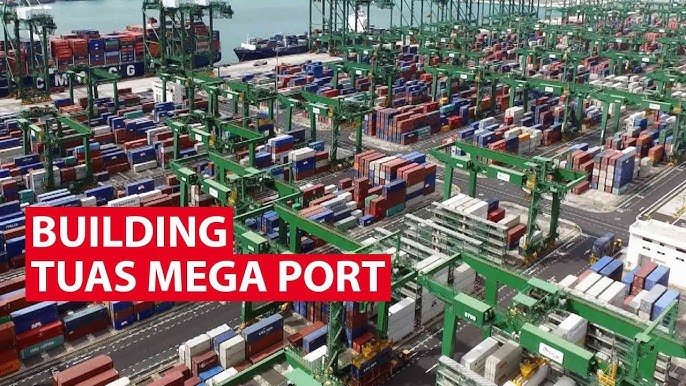Singapore is known around the world as a key player in global trade. Its busy ports handle millions of containers every year, making it a vital hub. Now, the country is taking a bold step forward with a project that could change the face of shipping forever. That project is the Tuas Mega Port—a massive £10 billion development set to become the world’s largest port by the 2040s. This new port will keep Singapore at the forefront of international trade, and its impact goes far beyond just logistics.
The Vision and Significance of the Tuas Mega Port
Singapore’s Shipping Industry and Strategic Position
Singapore has long been a top transshipment hub, connecting ships from every corner of the world. Its strategic location between Asia and the Middle East makes it the perfect stop for shipping lines. But as trade grows, the current ports are feeling the pressure. They simply can’t keep up with future demand. That’s where Tuas Mega Port comes in. It’s designed to support Singapore’s goal of staying a global shipping powerhouse for decades to come.
Project Goals and Expected Impact
This port aims to massively boost container handling capacity. It’s built to handle more ships, more cargo, and bigger vessels that are coming in the future. With this expansion, Singapore will strengthen its position in maritime logistics. Economically, Tuas Mega Port is expected to attract investments, create jobs, and support regional growth. It’s not just about size; it’s about making Singapore more competitive and impactful on the world stage.
Environment and Sustainability Commitments
Building such a large port means special care must be taken for the environment. The project emphasizes green practices too. It features eco-friendly technologies and energy-saving infrastructure. From renewable energy sources to waste recycling programs, Singapore aims to keep the port sustainable. This aligns with global standards and commitments to reduce environmental impacts while still growing.
Development and Construction of Tuas Mega Port
Project Phases and Timeline
The port’s journey began years ago, and it’s still ongoing. The project is structured into several phases, each with its own milestones. The first step involved land reclamation and basic infrastructure. Over the next decades, the port will see deep-water berths, automated terminals, and cutting-edge facilities. By the 2040s, everything should be up and running, making it the largest port worldwide.
Infrastructure Features and Innovation
What makes Tuas Mega Port stand out? It’s packed with smart features. The port will boast state-of-the-art cargo handling systems powered by automation and robotics. AI and IoT will ensure operations run smoothly and efficiently. Deep-water berths will allow giant ships to dock easily, while specialized cranes and container systems speed up loading and unloading. The port will be truly modern.
Challenges and Solutions
Building a port of this size isn’t simple. It faces technical hurdles like land reclamation and environmental worries. To reduce these impacts, Singapore is adopting innovative solutions, such as eco-friendly construction practices and green technology. Plus, close collaboration with global partners helps solve logistical issues fast. The project’s success depends on teamwork, innovation, and careful planning.
Economic and Global Trade Implications
Boosting Singapore’s Port Capacity and Competitiveness
Right now, Singapore handles a significant slice of world trade, but it needs room to grow. Once completed, Tuas Mega Port will quadruple current container capacity. This will help Singapore stay ahead of rivals like Hong Kong and Rotterdam. It also secures its place as a top maritime hub, supporting regional supply chains better than ever.
Regional and Global Trade Growth
With this new port, Singapore will be even more connected to major markets. It opens new shipping routes and makes regional trade faster and more reliable. Big multinational logistics companies are likely to set up shop nearby, seeing the port’s potential. Ultimately, Tuas will help Asia-Pacific trade flourish more than ever.
Job Creation and Economic Development
Construction alone has created thousands of jobs. Once operational, the port will need skilled workers, engineers, and port management specialists. That means more employment opportunities for Singaporeans and the region. It’s not just about the port’s size, but how it sparks ongoing growth in related industries like shipping, manufacturing, and logistics services.
Environmental and Technological Innovations
Sustainable Operations and Eco-Friendly Initiatives
Tuas Mega Port isn’t just big; it’s green. It plans to use renewable energy sources like solar and wind. Waste management systems will minimize pollution. Also, initiatives like preserving nearby marine life and reducing carbon footprints make it a leader in sustainable port operations.
Smart Port Technologies
Automation is key here. Robots will handle cargo, and data analytics will keep everything running smoothly. AI will predict and prevent maintenance issues, while IoT connects all parts of the port for real-time management. Digital twin technology creates virtual models to test improvements before implementation. These innovations boost efficiency and cut costs.
Global Benchmarking and Best Practices
Looking abroad can offer valuable lessons. Ports like Rotterdam and Hong Kong have paved the way with some of the most advanced port tech. Singapore is adopting these best practices and tailoring them to its needs. This approach helps Tuas Mega Port become a world-class example for smart logistics.
Future Outlook and Strategic Importance
Timeline to 2040s: What to Expect
Over the next two decades, the port will go through several key phases of expansion. Every stage will introduce new technologies, larger capacities, and better infrastructure. It’s a continuous journey to keep up with global trade winds and technological advances.
Strategic Role in Global Supply Chains
Tuas Mega Port is set to become a resilient link in global supply chains. Its size and automation will keep shipments moving even amid disruptions like pandemics or political unrest. Singapore’s reputation as a logistics hub will only grow stronger.
Long-term Economic and Environmental Goals
Beyond size, the port aligns with Singapore’s green plans. It aims to balance growth with sustainability, helping the country meet its climate commitments. This long-term vision could serve as a blueprint for ports worldwide—demonstrating how growth and environmental responsibility can go hand in hand.
Conclusion
Tuas Mega Port marks a major shift for Singapore and the billions of dollars of global trade it supports. Its giant scale, focus on sustainability, and innovative tech will shape the future of shipping. When completed, this port is set to change how we think about maritime logistics, anchoring Singapore’s leadership for decades. Keep an eye on this project—its developments will redefine the shipping universe and open new trade opportunities for everyone.
Stay updated on Tuas Mega Port—a project set to transform global shipping, making Singapore the ultimate gateway into the future.

